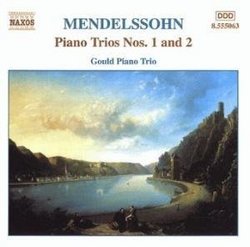| All Artists: Felix Mendelssohn, Gould Piano Trio Title: Mendelssohn: Piano Trios 1 & 2 Members Wishing: 0 Total Copies: 0 Label: Naxos Original Release Date: 1/1/2002 Re-Release Date: 1/15/2002 Genre: Classical Styles: Chamber Music, Historical Periods, Classical (c.1770-1830) Number of Discs: 1 SwapaCD Credits: 1 UPC: 747313506323 |
Search - Felix Mendelssohn, Gould Piano Trio :: Mendelssohn: Piano Trios 1 & 2
 | Felix Mendelssohn, Gould Piano Trio Mendelssohn: Piano Trios 1 & 2 Genre: Classical
|
Larger Image |
CD Details |
CD ReviewsLovely Mendelssohn Piano Trios Robin Friedman | Washington, D.C. United States | 03/23/2006 (5 out of 5 stars) "All too often, the music of Felix Mendelssohn (1809-- 1847) is treated dismissively as a sort of overly polished and bland specimen of Victorian romanticism. This CD of Mendelssohn's two piano trios should go a long way towards correcting this view. Mendelssohn's two piano trios are both in the minor key. They both are full of passion, lyricism, and intimacy. The works were written to be performed by capable amateur musicians in the intimacy of the home, a type of "hausmusik" that, alas, is not common today. But the trios are delightful to hear for the multitude of music lovers that, in our day, do not play or have the opportunity to play. The music is fully accessible and will appeal to those coming for the first time to chamber music as well as to experienced listeners. The trios are performed by the Gould Piano Trio, an ensemble consisting of three young English musicians: Lucy Gould, Violin, Martin Storey, cello, and Benjamin Firth, piano. The performance is exquisite, with great expression and musicianship both in ensemble and in solo passages. The disk has received substantial critical acclaim. Mendelssohn's first piano trio in D minor opus 49 dates from 1837 while the second piano trio in C minor opus 66 dates from 1845. Each work is in four movements. Both trios have extended and brilliant piano parts (I am a pianist at heart.) while the first trio spotlights the cello considerably more that does the second. There are many similarities between the two trios, but each has a voice of its own. The first movement of the D minor features two melancholy and lyrical themes, each of which is stated initially by the cello. The opening movement of the C minor trio opens with a dark arpeggio passage for the piano and continues with a pleading, passionate theme first stated in the violin. The opening movements of both works include large minor-key climaxes, big chordal passages for the piano, and passionate endings. Each trio has a lovely, lyrical slow movement which begins with a lengthy piano solo -- that of the C minor trio is rather the more introspective. In both trios, the cello and violin complement the piano and give the slow movements warm flowing characters contrasting to the outbursts in the opening movements. Both trios include a light, quickly-paced scherzo of a type unique to Mendelssohn. The D minor begins with quick, repeated passages for the ensemble which develop into a brief, energetic middle section and which return in a quiet, light and energetic close. The scherzo of its companion features an endlessly spinning figuration in the piano accompanied by themes in the violin and cello. The movement includes long running light passagework for the piano and a soft pizzicato close in the strings. The finales of both trios are rondos which open in the minor key, progress through a series of episodes with clangorous piano chordal writing and shimmering arpeggios and contrasting dramatic or lyrical passages for the cello and violin. Both finales work themselves at length into the major key and end on a tone of triumph. This recording of Mendelsshon's piano trios is full of the intimacy and joy in music-making that characterize chamber music at its best. Robin Friedman" Fabulous music and performances Gontroppo | Bathurst, NSW Australia | 09/19/2004 (5 out of 5 stars) "Firstly, as a pianist, I'd like to register a protest vote: this piano trio is named after the violinist! But the recording is a wonderful bargain. The whole recording is terrific, but the first trio is particularly outstanding. I recommend this recording for seasoned lovers of trios, but also as a great way in for anyone who has not experienced piano trios before. I doubt if there is a more delightful composition or performance than the first Mendelssohn Piano Trio. Highly recommended" Mendelssohn Piano Trios Bill Atkinson | Staunton,VA USA | 12/09/2007 (5 out of 5 stars) "To most individuals, Mendelssohn is a pleasant Nineteenth Century composer comparable to the painter Dante Gabriel Rosseti or the poet Elizabeth Barrett Browning. They have heard the Wedding March, the Hebrides overture, and perhaps snippets from Elijah. In my estimation, he was also a major composer of chamber music second only to Beethoven and then Schubert.
The first trio is well balanced with a darkly driving first movement. This is succeeded by a second movement which seems to be a cross between a lullaby and a hymn. The third movement is pert and the last is suggestive of an Eastern European dance. The initial movement of the second trio has an intensity similar to its counterpart in the first trio. The second movement is undistinguished but the third has a marked similarity to one of the passages in the Midsummer Nights music. The last movement displays a broadly expansive melody. The Gould Piano Trio (Lucy, not Glenn)gives a well balanced performance and the recording has the technical excellence usually attained by Naxos. If you like these recordings, try the series issued by Naxos particularly the sixth quartet which has the poignance and emotional intensity of the first Smetana quartet. (Incidently I do not recommend the Naxos recording of the Smetana.)" |

 Track Listings (8) - Disc #1
Track Listings (8) - Disc #1